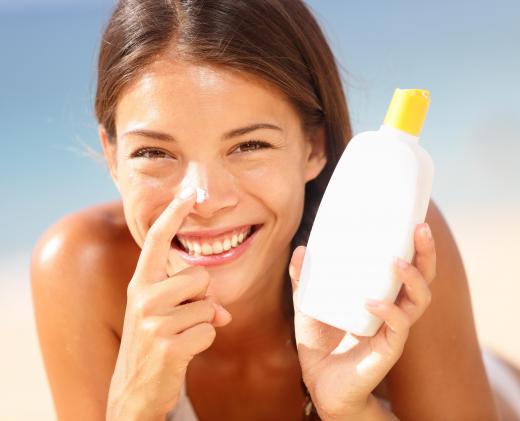What Is a UV Absorber?
The sun creates a wide range of light frequencies, both visible and invisible to humans. One range of frequencies that can be damaging to skin and man-made materials is ultraviolet (UV) light, or light with frequencies higher than the visible violet range. Ultraviolet light can cause cancers in humans with repeated long-term exposure, and chemically degrades plastics and other materials. A UV absorber can be added to sunscreen or manufactured products to absorb or reflect damaging UV light.
Three ranges of frequencies called UVA, UVB, and UVC normally define ultraviolet light. The majority of ultraviolet light that reaches the Earth's surface is classified as UVA, and all types can be damaging. UVA light has the longest frequency range, and has been shown to penetrate further into human skin, potentially causing the most damage. It was believed that UVA light was the primary cause of human skin cancer, but research in the late 20th century showed a relationship of UVB to cancer development as well.

A UV absorber can provide protection in one of two ways. Solids such as carbon black, titanium dioxide, and zinc oxide reduce UV light by either absorbing it in the case of carbon black, or reflecting it away in the case of the two oxides that are pure white in color. Sunscreens, paints and some plastics use combinations of titanium or zinc oxides to provide protection. Tires and rubber products may use carbon black to protect them from light damage.

Organic chemicals can provide UV protection by chemically absorbing the UV light and creating heat. These materials do not affect the transparency, or light transmission, of materials. They are commonly used in clear or translucent plastics, adhesives and clear-coat paints. Organic absorbers to not react chemically with the materials they are protecting.

Another class of compounds used along with absorbers is UV stabilizers. These chemicals typically are classified as hindered amine light stabilizers (HALS) that chemically react with molecules formed from UV reactions with the materials. HALS function as scavengers of the harmful molecules that can attack and degrade the plastics or other products. A UV absorber and stabilizer can be added in combination to a product formulation to provide optimum protection.

Lead oxide had been used in paints as a coloring agent and UV absorber for centuries, until research in the 20th century showed a relationship between lead paint and disabilities in children. Most household paints now use titanium dioxide, a mineral produced from natural sand deposits, as a whitening agent and UV protector. Calling mineral oxides a UV absorber is perhaps incorrect, because they are reflectors that scatter the incoming light. The effect is the same, however, and titanium dioxide is effective in reducing damage from ultraviolet light.
AS FEATURED ON:
AS FEATURED ON:














Discuss this Article
Post your comments